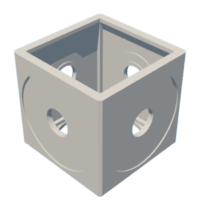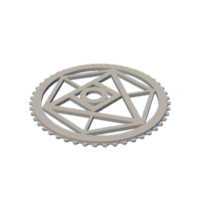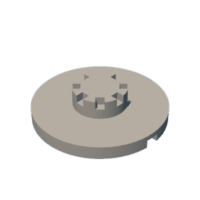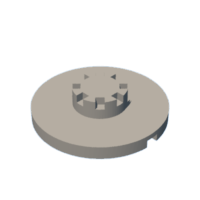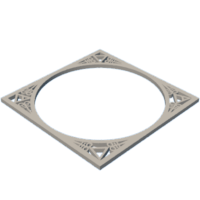Introduction: The Alchemist's Cube - a 3D Printed Puzzle Box
You find yourself in the abandoned laboratory of some long forgotten alchemist. Heavy dust coats every gloomy surface and thick sheets of spider web sprawl from every piece of furniture. Glass alchemic apparatus lay broken and strewn across the floor, amongst the scraps of aged parchment and toppled open books. You cautiously approach the cluttered desk, drawn to an object that seems out of place. What sits on the desk has gathered no dust, no spider dare approach it; an eerie hum as the immaculate object radiates a curious energy. What sits before you is the mysterious artefact known only as The Alchemist's Cube...
This is a fully 3D Printed puzzle box with a storage compartment suitable for the safe storage of your Philosopher's stone... or any other treasure that will fit inside. The alchemic decorations bring a sense of wonder to this mysterious box, and make for a great addition to any roleplaying game, such as D&D. The lid of the box is held in place by four internal rotating wheels that are connected to external dials. When the four wheels are orientated correctly, the lid can slide out via a keyway, and reveal the hidden treasure within. The lid is restricted to only moving vertically and, with a well calibrated printer, it will not wobble or reveal any hints if the puzzle is only partially solved. Each external dial features 8 alchemic symbols, making a total of 4096 possible permutations. The combination of symbols are chosen during assembly and can't be changed once glued together, so choose carefully.
Each face also features an intricate decorative panel that gives the box an arcane aesthetic. The decorative panel on the top of the box is slightly different to the sides and features a subtly different symbol in each corner. They are the alchemic symbols for Earth, Air, Fire, and Water, they are intended to help identify and differentiate the four dial faces, in the case that they are all printed in the same colour.
Supplies
Access to a 3D printer - Mine is an ELEGOO Neptune 3 Plus, but any well configured printer will work.
PLA filament - Use whatever colours you like - the colours I used for the dials were silk dual-colour filaments, and the decorations were a silk tri-colour filament of pink-blue-green.
Super Glue - I use Everbuild High Viscosity Superglue, but you can use any superglue that works for you.
Step 1: Printing
There are 12 STL files in total, however, you will not need all of them. There are some optional design choices when selecting the STLs to print. The files are included below but you can also download them from Thingiverse here.
The first option is in the internal keyway wheels, of which there are two kinds. You will need four wheels in total, but you can choose any combination of the two kinds. The first type is a simple single keyway wheel which totally restricts movement at any angle other than the correct angle. The other keyway wheel has a false keyway at 90° to the real one. This was included in case there was some wobble in the lid that might give away when the correct symbol was selected. A false keyway is intended to confuse anyone trying to open the box by feel, however, I have found that the lid is restricted enough to make opening by feel very difficult, even with no false keyways included.
The second design choice regards the top edge cap. Again, there are two types to choose from. The first is simply a decorative piece intended to make the edges look nice. The other type does the same thing, but features four arrows that give the user a marker to align the chosen symbol to.
The print list of STLs you will need to print is as follows:
Body - x1 - Supports Required
Core - x1 - Supports Required
Inner Wheel - x4 (any combination of the two types, see note above) - Supports Required
Core Decoration - x1 - No Supports Required
Base - x1 - No Supports Required
Top Decoration - x1 - No Supports Required
Outer Wheel Dial - x4 - No Supports Required
Side Wall Decoration - x4 - No Supports Required
Edge Trim - x4 - No Supports Required
Top Edge Cap - x1(choose one from two types, see note above) - No Supports Required
Each STL file should import into your slicer in the best orientation for printing, but feel free to make changes to suit your printer. All parts were printed with a 20% infill and 3 walls to add a bit of strength.
Attachments
Step 2: Assembly - Wheels and Dials
Assembly is fairly quick and straight forward. Start by placing the internal wheels into the body and line up the keyway with the top of the body; the top is the face with the large round hole. Check that the wheels spin freely without being too loose.
next, take an outer dial and select which symbol you wish to be the one that allows the box to open. Align that symbol with the keyway of the internal wheel and, with a dab of glue, snap it into place. The internal wheels and dials have gear teeth that will help to align the symbol perfectly. Push them firmly together to ensure they are inserted all the way and check again that it all spins freely. Only use a little glue to prevent it from squeezing out and sticking the wheel to the body. Repeat this for all four wheel and dial pairs.
Step 3: Assembly - the Base
The base simply inserts into the body via the large square opening of the cube. The orientation of this part does not matter as it is symmetrical. Run a dab of glue around the edge of the base part and press it into the body. It should click into place, but be sure to check for gaps along the mating faces, and push together to close them.
Step 4: Assembly - Decorations
All that remains now are the decorative pieces. Use a bit of glue on each corner and carefully position the decorative wall panels. Check again that the dial spins freely without catching the decorative panel.
The circular decorative piece is glued to the lid of the core. You will notice that the edge has a step to it. Orientate the decorative piece so that the step leaves a gap between the core and the decorative piece. This slight gap helps the user to grip the lid when pulling it out.
I found that it was easier to, at this point, insert the core piece into the body to help guide the position of the final top decorative panel. As with the other panels, add a little bit of glue on the corners and press it into place. Check that the core can move in and out without catching the decorative panel.
Once all the panels are glued into position, add a few dabs of glue to the top edge cap and fix it around the top edge of the cube. Finally, glue into position the four edge trims to complete the assembly of The Alchemist's Cube.

Participated in the
Anything Goes Contest







